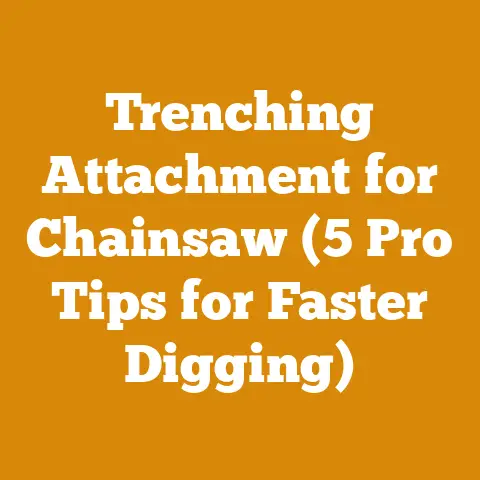Knots for Tree Work: Essential Ties for Safe Rigging (5 Pro Tips)
Imagine standing tall in a forest, the scent of pine heavy in the air, a massive oak before you.
The task?
Safely rigging and removing a large limb, ensuring the health of the tree and the safety of everyone around.
This is where knowledge of essential tree work knots isn’t just a skill; it’s a lifeline.
This article will delve into the world of knots for tree work, exploring essential ties for safe rigging and offering pro tips to elevate your skills.
Knots for Tree Work: Essential Ties for Safe Rigging (5 Pro Tips)
As someone who has spent years felling trees and processing wood, I can attest that mastering the right knots is as important as having a sharp chainsaw.
It’s the difference between a smooth, controlled operation and a potentially disastrous one.
The user intent here is clear: to learn about essential knots for safe tree work, especially rigging, and to gain practical tips for improvement.
Understanding the Critical Role of Knots in Tree Work
Before we dive into specific knots, let’s establish why they are so crucial.
In tree work, knots aren’t just about tying ropes together.
They are about:
- Safety: Securely anchoring lines to prevent slippage and failure.
- Control: Facilitating controlled lowering of heavy limbs.
- Efficiency: Streamlining rigging operations for faster, safer work.
- Load Distribution: Evenly distributing weight to prevent stress on equipment and the tree.
The integrity of your rigging system hinges on the strength and reliability of your knots.
A poorly tied knot can unravel under load, leading to equipment damage, personal injury, or even fatalities.
Essential Knots for Tree Work: A Deep Dive
Here are five essential knots every arborist and tree worker should master, along with detailed instructions and tips:
1. The Bowline: The King of Loops
The bowline is a foundational knot for creating a secure loop that won’t slip or tighten under load.
It’s often called the “King of Knots” for its versatility and reliability.
- Uses: Creating an eye at the end of a rope for attaching to a carabiner, forming a loop for hoisting tools, or connecting to a rigging point.
-
How to Tie:
- Form a small loop in the standing part of the rope.
- Pass the working end up through the loop.
- Around the standing part.
- Back down through the loop.
- Dress the knot by tightening it neatly.
Pro Tip: Always leave a long tail (at least 6 inches) on the working end of the rope.
This prevents the knot from accidentally coming undone.
A back-up knot is always recommended.Safety Note: While the bowline is strong, it can loosen slightly under fluctuating loads.
For critical applications, consider using a bowline with a Yosemite finish or a doubled bowline for added security.Cost Implication: Improper use of bowline can cause a rigging failure, leading to costs associated with equipment damage, project delays, and potential injuries.
Proper training on bowline usage is a worthwhile investment.
2. The Timber Hitch: For Dragging Logs and Simple Rigging
The timber hitch is a simple yet effective knot for attaching a rope to a log or other cylindrical object.
It’s quick to tie and provides a secure hold that tightens under tension.
- Uses: Dragging logs, attaching a rope to a spar for lifting, or creating a temporary anchor point.
-
How to Tie:
- Pass the rope around the log.
- Bring the working end back along the rope and wrap it around itself at least three times.
- Pass the working end under the loop formed around the log.
- Tighten the knot by pulling on the standing part of the rope.
-
Pro Tip: For added security, especially when dragging heavier logs, add an extra wrap or two around the rope.
Safety Note: The timber hitch can slip if the load is applied unevenly or if the log is very smooth.
Monitor the knot carefully and adjust as needed.Cost Implication: The timber hitch is often used in conjunction with other knots.
If a timber hitch fails, it can cause a log to roll unexpectedly, potentially damaging equipment, like chainsaws ($300 – $1,500 to replace) or causing injuries to crew members.
3. The Prusik Hitch: For Climbing and Friction Control
The Prusik hitch is a versatile friction hitch used for ascending ropes, creating a temporary anchor point, or controlling the descent of a load.
It’s tied using a loop of cord around a larger diameter rope.
- Uses: Climbing a rope, creating a progress capture system, or acting as a brake for lowering a load.
-
How to Tie:
- Form a loop with a length of cord (Prusik cord).
- Wrap the loop around the main rope several times (typically 3-5 wraps).
- Pass the ends of the Prusik cord through the loop.
- Tighten the hitch by pulling on both ends of the Prusik cord.
Pro Tip: Use a Prusik cord that is slightly smaller in diameter than the main rope.
This will ensure that the hitch grips properly.Safety Note: The Prusik hitch relies on friction to hold.
It can slip if the load is too heavy or if the ropes are wet or icy.
Always test the hitch before applying a full load.Cost Implication: Prusik hitches are integral to climbing systems.
A failure in a Prusik hitch during a climb can lead to a fall, resulting in significant medical expenses and potential worker compensation claims.
Investing in high-quality Prusik cord ($20 – $50 per length) and proper training is crucial.
4. The Clove Hitch: A Quick and Versatile Anchor
The clove hitch is a simple and quick knot for attaching a rope to a spar, pole, or ring.
It’s relatively easy to tie and untie, making it useful for temporary anchor points.
- Uses: Securing a rope to a tree trunk, attaching a rope to a carabiner, or creating a temporary anchor point for rigging.
-
How to Tie:
- Pass the rope around the object you want to attach to.
- Cross the rope over itself and pass it around the object again.
- Tuck the working end under the last wrap.
- Tighten the knot by pulling on both ends of the rope.
-
Pro Tip: For added security, especially when the clove hitch is under tension, finish it off with two half hitches.
Safety Note: The clove hitch can slip if the load is applied unevenly or if the object it’s attached to is very smooth.
Monitor the knot carefully and adjust as needed.Cost Implication: Clove hitches are often used for securing tag lines.
If a clove hitch fails on a tag line, it can cause a load to swing unexpectedly, potentially damaging property or causing injuries.
The cost of damage can range from minor repairs ($100s) to significant structural damage ($10,000s).
5. The Figure-Eight Knot: A Stopper Knot You Can Trust
The figure-eight knot is a reliable stopper knot used to prevent a rope from running through a device or hole.
It’s strong, easy to inspect, and relatively easy to untie even after being heavily loaded.
- Uses: Preventing a rope from running through a belay device, creating a secure end loop, or acting as a backup knot in a rigging system.
-
How to Tie:
- Form a loop in the rope.
- Bring the working end over and around the standing part of the rope.
- Pass the working end through the loop.
- Tighten the knot by pulling on both ends of the rope.
Pro Tip: Leave a generous tail (at least 12 inches) on the working end of the rope.
This makes the knot easier to inspect and untie.-
Safety Note: While the figure-eight knot is strong, it’s essential to dress the knot properly by tightening it neatly and ensuring that all parts of the knot are snug.
Cost Implication: Figure-eight knots are often used as a termination point in climbing and rigging systems.
A failure in a figure-eight knot can have catastrophic consequences, potentially leading to severe injuries or fatalities.
The legal and insurance costs associated with such incidents can be substantial.
Pro Tip #1: Rope Inspection – Your First Line of Defense
Before you even think about tying a knot, inspect your rope. Look for:
- Abrasion: Fraying, cuts, or worn spots.
- Damage: Kinks, flat spots, or discoloration.
- Contamination: Dirt, oil, or chemicals.
Any of these signs could compromise the rope’s strength and make it unsafe for use.
I once had a rope snap during a rigging operation because I hadn’t noticed a small cut hidden beneath a layer of dirt.
Fortunately, no one was hurt, but it was a valuable lesson.
- Cost Implication: Regular rope inspections can prevent costly accidents.
Replacing a damaged rope ($50 – $500) is a small price to pay compared to the potential costs of an accident caused by rope failure.
Pro Tip #2: Knot Tying Practice – Repetition is Key
Mastering knots takes time and practice.
Don’t wait until you’re high up in a tree to try tying a knot for the first time.
Practice tying each knot repeatedly until you can tie it quickly and confidently, even with your eyes closed.
I often practice while watching TV or waiting in line.
It might seem silly, but it pays off in the field.
- Cost Implication: Investing time in knot-tying practice reduces the risk of errors that can lead to accidents.
The cost of training courses and practice materials ($100 – $500) is a worthwhile investment in safety and efficiency.
Pro Tip #3: Knot Dressing and Setting – Attention to Detail
A properly tied knot is only as good as its dressing and setting.
“Dressing” refers to arranging the strands of the knot neatly to ensure it’s properly formed.
“Setting” involves tightening the knot firmly before applying a load.
- Dressing: Ensure that the strands of the knot are parallel and that there are no twists or kinks.
- Setting: Pull on all parts of the knot to tighten it evenly.
This helps to distribute the load and prevent slippage.
I’ve seen knots fail simply because they weren’t dressed and set properly.
It’s a small detail that can make a big difference.
- Cost Implication: Proper knot dressing and setting can prevent premature wear and tear on ropes, extending their lifespan.
This can save money on rope replacement costs over time.
Pro Tip #4: Knot Selection – Choosing the Right Tool for the Job
Not all knots are created equal.
Each knot has its own strengths and weaknesses, and it’s important to choose the right knot for the specific application.
For example, a bowline is great for creating a secure loop, but it’s not ideal for attaching a rope to a log.
A timber hitch is better suited for that task.
Consider the following factors when selecting a knot:
- Load: How much weight will the knot be supporting?
- Direction of Pull: Will the load be applied in a straight line or at an angle?
- Rope Type: Is the rope static or dynamic?
-
Environmental Conditions: Will the knot be exposed to moisture, dirt, or extreme temperatures?
Cost Implication: Using the wrong knot for the job can lead to knot failure and potential accidents.
Choosing the right knot can prevent these accidents and the associated costs.
Pro Tip #5: Continuous Learning – Stay Up-to-Date
The world of tree work is constantly evolving, with new techniques and equipment being developed all the time.
It’s important to stay up-to-date on the latest best practices and safety standards.
Attend workshops, read industry publications, and network with other tree workers to expand your knowledge and skills.
I make it a point to attend at least one arboriculture conference each year.
It’s a great way to learn about new techniques, network with other professionals, and stay on top of the latest safety regulations.
- Cost Implication: Continuous learning can improve efficiency and reduce the risk of accidents.
The cost of training and professional development ($200 – $1,000 per year) is a worthwhile investment in your career and the safety of your crew.
Cost Considerations: The Tangible and Intangible Expenses
While the focus here is on knot tying, it’s crucial to understand the broader cost implications of safe tree work.
Ignoring safety protocols can lead to:
- Equipment Damage: Broken ropes, damaged chainsaws, and other equipment failures.
Replacing a professional-grade chainsaw can easily cost $1,000 or more. - Lost Productivity: Delays due to accidents, equipment failures, or injuries.
Even a minor injury can sideline a worker for days or weeks, impacting project timelines and profitability. - Medical Expenses: Treatment for injuries sustained during tree work.
Medical bills can quickly escalate, especially for serious injuries requiring surgery or long-term care. - Liability Claims: Lawsuits resulting from accidents or property damage.
Liability claims can be incredibly expensive, potentially bankrupting a small business. - Increased Insurance Premiums: Higher insurance rates due to a poor safety record.
Insurance premiums can significantly impact a company’s bottom line. Fines and Penalties: Regulatory fines for safety violations.
OSHA fines can be substantial, especially for repeat offenses.Intangible Costs: The emotional toll on workers and their families after an accident.
The loss of trust and morale within a team.
Damage to the company’s reputation.Data-Driven Perspective: According to the Tree Care Industry Association (TCIA), the average cost of a lost-time injury in the tree care industry is over $40,000.
This includes medical expenses, lost wages, and other associated costs.
Budgeting for Safety: A Proactive Approach
Investing in safety is not just the right thing to do; it’s also good business.
Here’s how I approach budgeting for safety in my tree work operations:
- Training: Allocate funds for regular training on knot tying, rigging techniques, chainsaw safety, and first aid/CPR.
I budget at least $500 per employee per year for training. - Equipment: Invest in high-quality ropes, harnesses, helmets, and other safety equipment.
Don’t skimp on safety gear.
I budget at least $1,000 per employee for initial safety equipment and allocate funds for regular replacement. - Maintenance: Establish a regular maintenance schedule for all equipment, including ropes, chainsaws, and rigging gear.
Proper maintenance can extend the lifespan of equipment and prevent failures. - Inspections: Conduct regular inspections of all equipment and work sites to identify potential hazards.
I use a checklist to ensure that all critical safety items are inspected regularly. - Emergency Preparedness: Develop an emergency response plan and ensure that all workers are familiar with it.
This includes having a first aid kit on site and knowing how to contact emergency services.
By proactively budgeting for safety, you can minimize the risk of accidents and the associated costs.
Case Study: The Cost of a Preventable Accident
I once worked on a project where a subcontractor cut corners on safety to save time and money.
They used a damaged rope and failed to properly tie a knot.
The rope snapped, causing a heavy limb to fall unexpectedly.
Fortunately, no one was seriously injured, but the incident resulted in:
- Equipment Damage: The falling limb damaged a nearby vehicle, costing $3,000 to repair.
- Lost Productivity: The project was delayed by two days, costing $1,000 in lost revenue.
- Increased Insurance Premiums: The subcontractor’s insurance premiums increased by 10% for the next three years, costing an additional $1,500 per year.
In total, the preventable accident cost the subcontractor over $8,500.
This doesn’t even include the intangible costs of the stress and anxiety caused by the incident.
If the accident had resulted in a serious injury, the costs would have been much higher.
Current Industry Benchmarks and Statistical Data
To put these costs into perspective, here are some current industry benchmarks and statistical data:
- Average Price per Cord of Firewood: According to the USDA Forest Service, the average price per cord of firewood in the United States ranges from $200 to $400, depending on the species, location, and demand.
Accidents during firewood preparation can significantly impact profitability. - Average Cost of a Chainsaw Injury: According to the Centers for Disease Control and Prevention (CDC), the average cost of a chainsaw injury is over $30,000.
This includes medical expenses, lost wages, and other associated costs. - OSHA Fines for Safety Violations: OSHA fines for safety violations can range from a few hundred dollars to tens of thousands of dollars, depending on the severity of the violation and the company’s history.
-
Workers’ Compensation Rates: Workers’ compensation rates for tree work are among the highest in the construction industry, reflecting the high risk of injury.
-
Data Source: These figures are based on data from the USDA Forest Service, the CDC, OSHA, and the National Council on Compensation Insurance (NCCI).
Practical Tips for Cost Optimization and Budget Management
Here are some practical tips for optimizing costs and managing your budget in tree work and firewood preparation:
- Plan Ahead: Develop a detailed plan for each project, including a list of all necessary equipment, materials, and labor.
This will help you avoid unexpected expenses. - Shop Around: Get quotes from multiple suppliers for equipment, materials, and insurance.
Don’t be afraid to negotiate. - Maintain Your Equipment: Regular maintenance can extend the lifespan of your equipment and prevent costly breakdowns.
- Track Your Expenses: Keep track of all your expenses, including equipment, materials, labor, and insurance.
This will help you identify areas where you can save money. - Invest in Training: Training can improve efficiency, reduce the risk of accidents, and increase productivity.
- Embrace Technology: Use technology to streamline your operations, such as GPS tracking for equipment, cloud-based project management software, and mobile apps for safety inspections.
- Minimize Waste: Reduce waste by carefully planning your cuts, using efficient wood processing techniques, and recycling or repurposing wood scraps.
- Consider Alternative Methods: Explore alternative methods for tree removal and firewood preparation, such as using a wood chipper instead of burning brush or using a hydraulic log splitter instead of splitting wood by hand.
- Monitor Market Trends: Stay up-to-date on market trends for timber, firewood, and equipment.
This will help you make informed decisions about pricing and purchasing. - Build Relationships: Build strong relationships with suppliers, customers, and other industry professionals.
This can help you get better deals, find new opportunities, and stay ahead of the competition.
Relevant Calculations and Formulas
Here are some relevant calculations and formulas that can help you estimate costs and manage your budget:
- Calculating Volume of Logs in Board Feet: Board feet = (Length in feet x Width in inches x Thickness in inches) / 144
- Calculating Volume of Logs in Cords: Cords = (Length in feet x Width in feet x Height in feet) / 128
- Estimating Drying Time for Firewood: Drying time depends on wood species, moisture content, and climate.
Generally, hardwoods take 6-12 months to dry, while softwoods take 3-6 months. - Estimating Fuel Consumption for Chainsaws: Fuel consumption depends on chainsaw size, wood species, and cutting conditions.
Generally, a chainsaw will consume 1-2 gallons of fuel per day.
Actionable Takeaways and Next Steps
- Master the Essential Knots: Practice tying the bowline, timber hitch, Prusik hitch, clove hitch, and figure-eight knot until you can tie them quickly and confidently.
- Prioritize Rope Inspection: Inspect your ropes regularly for signs of damage and replace them as needed.
- Invest in Training: Attend workshops and conferences to stay up-to-date on the latest best practices and safety standards.
- Budget for Safety: Allocate funds for training, equipment, and maintenance to minimize the risk of accidents.
- Plan Ahead: Develop a detailed plan for each project, including a list of all necessary equipment, materials, and labor.
- Track Your Expenses: Keep track of all your expenses and identify areas where you can save money.
- Stay Informed: Monitor market trends and industry benchmarks to make informed decisions about pricing and purchasing.
By taking these steps, you can improve your skills, enhance your safety, and optimize your costs in tree work and firewood preparation.
Remember, safety is not just a priority; it’s a way of life.
A Final Word of Wisdom
Tree work and firewood preparation can be challenging but rewarding.
By mastering the essential knots, prioritizing safety, and managing your budget effectively, you can achieve success while minimizing risks.
As the old saying goes, “Measure twice, cut once.” This applies not only to cutting wood but also to planning and executing your projects safely and efficiently.
So, go forth, be safe, and may your knots always hold true.






